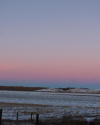

Title: Physics Phenomena in Sunsets.
In this photo there is a sunset and believe it or not, this sunset is due to a phenomena in physics. The beautiful colors we see in the sky, sunset orange or midday blue, are caused by the scattering of light from particles in the atmosphere. The Scattering responsible for the sunsets we see is called Rayleigh scattering. Rayleigh scattering is the scattering of light by the particles present in the atmosphere. Blue and violet light have the shortest wavelengths in the visible spectrum, this is why the sky appears blue during the day. In the late evening when the sky is painted with beautiful hues of orange, red, and pink, the sun has to go through more of the atmosphere before it is able to reach us and we can see it. The increase in area of the atmosphere at this time causes there to be way more particles to scatter the light, so at this point all of the blue and violet light has been scattered away. This allows the yellow, orange, and red light to scatter and give us a beautiful sunset. The more atmosphere the sun needs to go through, the redder the sky appears. Pollutants in the air can also add to the number of particles light needs to scatter through giving a more vibrant look to a sunset.
In my photo I wanted to capture water drops on a plant leaf, though, I wanted to add more character to the scene so I used a red light to reflect color off of the leaf and the water drops. This kind of reflection is called specular reflection. When specular reflection occurs our eyes perceive this light, allowing us to see the image of the object that produced the reflection. This is the basic principle behind why I was able to capture both the leaf and the red light inside of the water droplet.

Title : Over The Rainbow
Rainbows are most commonly pictured as colorful arches in the sky. They are seen as good luck and a promise of happiness. They are a meteorological phenomenon formed by the sun shining its light through water droplets, reflecting off of it and bending or splitting. This is called refraction and is why the rainbow faces the opposite of the sun. The most common rainbow is a primary bow and forms If the sunlight hits raindrops in front of someone at about a 42-degree angle, so it's normally seen early morning or late afternoon. The lower the sun is in the sky, the more of an arch it has. Technically, a rainbow doesn't even exist in one spot in the sky, it depends on where you are. To see one, you have to have your back towards the sun, and it either has to be raining, foggy or anywhere where there's water in the sky. Like maybe sea spray or near a waterfall. A rainbow is actually a full circle. However, we cannot see it from the ground because the antisolar point is the center of the circle. The water acts as tiny prisms and the reason that you can see the colors of the rainbow is because the light the sun gives off is white. It is a mixture of many vibrant colors including red, orange, yellow, green, blue, indigo, and violet. Red has the longest wavelength of light and Violet has the shortest. Scientists use a spectrometer to study the parts of the rainbow you can’t see. There are also many variations of rainbows like a double rainbow, twinned, reflection, reflected, red, fogbow, sundogs, and a moonbow.
Delicate Daylight
Natural
Down by the frozen lake of Mitchell SD. The reflection of the trees on the hills off of the ice are being caused from the light bouncing off the shiny smooth surface, which is like a flat mirror being reflected in only one direction. Using the law of reflection, this is a specular that states when an object bounces off of the surface, the angle will be equal to which it bounces off.
